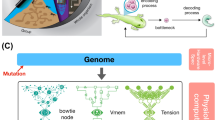Abstract
A developmental Artificial Neural Tissue (ANT) architecture inspired by the mammalian visual cortex is presented. It is shown that with the effective use of gene regulation that large phenotypes in the form of Artificial Neural Tissues do not necessarily pose an impediment to evolution. ANT includes a Gene Regulatory Network that controls cell growth/death and activation/inhibition of the tissue based on a coarse-coding framework. This scalable architecture can facilitate emergent (self-organized) task decomposition and require limited task specific information compared with fixed topologies. Only a global fitness function (without biasing a particular task decomposition strategy) is specified and self-organized task decomposition is achieved through a process of gene regulation, competitive coevolution, cooperation and specialization.
Preview
Unable to display preview. Download preview PDF.
Similar content being viewed by others
References
Albus, J.S.: A theory of cerebellar function. Mathematical Biosciences, 25–61 (1971)
Astor, J.C., Adami, C.: A developmental model for the evolution of artificial neural networks. ALife 6(3), 189–218 (2000)
Ballard, D.H.: Cortical Connections and parallel processing. The Behavioural and Brain Sciences 9, 279–284 (1986)
Deneubourg, J.-L.: Application de l’ordre par fluctuations ‘a la description de certaines ’etapes de la construction du nid chez les termites. Insectes Sociaux, 117–130 (1977)
Eggenberger, P., et al.: Evolving the orphology of a neural net for controlling a foveating retina. ALife 8, 243–251 (2002)
Eggenberger, P.: Evolving Morphologies of simulated 3d organism based on Differential Gene Expression. In: Proc. 4th European Conference on ALife (1997)
Gruau, F.: Automatic definition of modular neural networks. Adaptive Behaviours 3, 151–183 (1994)
Gustafson, S., et al.: Problem Difficulty and Code Growth in Genetic Programming. Genetic Programming and Evolvable Machines 5, 271–290 (2004)
Hinton, G.: Shape Representation in Parallel Systems. In: Proc. of 7th Int. Joint Conf. on Artificial Intelligence, pp. 1088–1096 (1981)
Hinton, G.: Product of Experts. In: Proc. of the 9th Int. Conf. on Artificial Neural Nets, vol. 1, pp. 1–6 (1999)
Hornby, G., Pollack, J.: Creating High-Level Components with a Generative Representation for Body-Brain Evolution. ALife 8 (2002)
Jacobs, R., Jordan, M., Barto, A.: Task decomposition through competition in a modular connectionist architecture. Cognitive Science (15), 219–250 (1991)
Stanley, K., Miikkulainen, R.: Continual Coevolution through Complexification. In: Proc. of the Genetic and Evolutionary Computation Conf. 2002 (2002)
Stanley, K., Miikkulainen, R.: A taxanomy for aritificial embrogeny. Artificial Life 9(2), 93–130 (2003)
Sims, K.: Evolving 3D Morphology and Behavior by Competition. In: Proc. of Artificial Life IV, pp. 28–39. MIT Press, Cambridge (1994)
Langdon, W.: Quadratic bloat in genetic programming. In: Proc. of Genetic and Evolutionary Comp. Conf. (2000)
Liu, Y., Yao, X., Higuchi, T.: Evolutionary Ensembles with Negative Correlation Learning. IEEE Transactions on Evolutionary Computation 4, 380–387 (2000)
Nolfi, S., Floreano, D.: Evolutionary Robotics: The Biology, Intelligence, and Technology of Self-Organizing Machines, pp. 13–15. MIT Press, Cambridge (2000)
Roggen, D., Floreano, D., Mattiussi, C.: A Morphogenetic Evolutionary System: Phylogenesis of the POEtic Tissue. In: Int. Conf on Evolvable Systems, pp. 153–164 (2003)
Roggen, D., Federici, D.: Multi-cellular Development: Is There Scalability and Robustnes to Gain? In: Proc. of Parallel Problem Solving from Nature, pp. 391–400 (2004)
Thangavelautham, J., D’Eleuterio, G.M.T.: A Neuroevolutionary Approach to Emergent Task Decomposition. In: Proc. of 8th Parallel Problem Solving from Nature, pp. 991–1000 (2004)
Author information
Authors and Affiliations
Editor information
Editors and Affiliations
Rights and permissions
Copyright information
© 2005 Springer-Verlag Berlin Heidelberg
About this paper
Cite this paper
Thangavelautham, J., D’Eleuterio, G.M.T. (2005). A Coarse-Coding Framework for a Gene-Regulatory-Based Artificial Neural Tissue. In: Capcarrère, M.S., Freitas, A.A., Bentley, P.J., Johnson, C.G., Timmis, J. (eds) Advances in Artificial Life. ECAL 2005. Lecture Notes in Computer Science(), vol 3630. Springer, Berlin, Heidelberg. https://doi.org/10.1007/11553090_8
Download citation
DOI: https://doi.org/10.1007/11553090_8
Publisher Name: Springer, Berlin, Heidelberg
Print ISBN: 978-3-540-28848-0
Online ISBN: 978-3-540-31816-3
eBook Packages: Computer ScienceComputer Science (R0)




